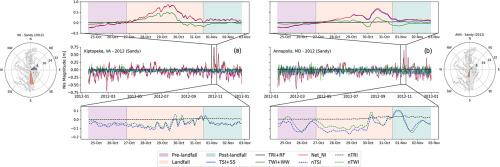Breaking down annual and tropical cyclone-induced nonlinear interactions in total water levels
IF 4.2
2区 环境科学与生态学
Q1 WATER RESOURCES
引用次数: 0
Abstract
With the increase of tropical cyclone activity, coastal communities will experience growing impacts from extreme water levels and associated compound flooding. Multiple drivers contribute to total water level (TWL), including mean sea level, astronomical tides, riverine flow, storm surges, and waves. Therefore, gaining insight into future TWL variability requires a thorough understanding of how those drivers nonlinearly interact at different spatiotemporal scales. In this study, we developed a coupled coastal and wave model at sufficient spatial resolution to analyze: (i) tide–driver interactions and their nonlinear components stemming from surge, river flow, and wind-waves, and (ii) their spatiotemporal evolution across the pre-landfall, landfall, and post-landfall stages of tropical cyclones in the Chesapeake Bay, USA. Results show that tide–surge and tide–wave interactions, along with their nonlinear components, exhibit substantial annual variability, with extreme hurricanes producing abrupt and spatially distinct responses driven by low pressure anomalies in slow-moving storms and wind setup in faster systems. In contrast, tide–river interactions remain negligible except in the upper bay tributaries. A weak or neutral tide–driver interaction does not necessarily indicate a negligible nonlinear response. Rather, nonlinear interactions (NIs) generally act out of phase with their associated drivers, functioning as compensatory mechanisms that amplify or suppress TWL. These nonlinearities are transient and of high-frequency nature near the coast, but evolve into slower, more persistent fluctuations in upstream regions. As climate change reshapes coastal dynamics, a robust understanding of NIs is essential for designing effective flood protection, enhancing risk assessments, and developing informed adaptation strategies for extreme water levels.

分解年和热带气旋引起的总水位非线性相互作用
随着热带气旋活动的增加,沿海社区将受到极端水位和相关复合洪水的越来越大的影响。多个驱动因素对总水位(TWL)有影响,包括平均海平面、天文潮汐、河流流量、风暴潮和波浪。因此,要深入了解未来TWL的变化,就需要彻底了解这些驱动因素在不同时空尺度上是如何非线性相互作用的。在这项研究中,我们开发了一个具有足够空间分辨率的海岸和波浪耦合模型来分析:(i)潮汐驱动相互作用及其非线性分量,包括风暴潮、河流流量和风浪,以及(ii)热带气旋在美国切萨皮克湾登陆前、登陆后和登陆后三个阶段的时空演变。结果表明,潮涌和潮波相互作用及其非线性成分表现出显著的年变异性,极端飓风在缓慢移动风暴的低压异常和快速系统的风力设置的驱动下产生突然的和空间上不同的响应。相比之下,除了海湾上游支流,潮汐与河流的相互作用仍然可以忽略不计。弱的或中性的潮汐驱动相互作用不一定表示可忽略的非线性响应。相反,非线性相互作用(NIs)通常与其相关驱动因素相异,作为放大或抑制TWL的补偿机制发挥作用。这些非线性是短暂的,在海岸附近具有高频性质,但在上游地区演变成较慢,更持久的波动。随着气候变化重塑沿海动态,深入了解极端水位对于设计有效的防洪措施、加强风险评估和制定明智的极端水位适应战略至关重要。
本文章由计算机程序翻译,如有差异,请以英文原文为准。
求助全文
约1分钟内获得全文
求助全文
来源期刊

Advances in Water Resources
环境科学-水资源
CiteScore
9.40
自引率
6.40%
发文量
171
审稿时长
36 days
期刊介绍:
Advances in Water Resources provides a forum for the presentation of fundamental scientific advances in the understanding of water resources systems. The scope of Advances in Water Resources includes any combination of theoretical, computational, and experimental approaches used to advance fundamental understanding of surface or subsurface water resources systems or the interaction of these systems with the atmosphere, geosphere, biosphere, and human societies. Manuscripts involving case studies that do not attempt to reach broader conclusions, research on engineering design, applied hydraulics, or water quality and treatment, as well as applications of existing knowledge that do not advance fundamental understanding of hydrological processes, are not appropriate for Advances in Water Resources.
Examples of appropriate topical areas that will be considered include the following:
• Surface and subsurface hydrology
• Hydrometeorology
• Environmental fluid dynamics
• Ecohydrology and ecohydrodynamics
• Multiphase transport phenomena in porous media
• Fluid flow and species transport and reaction processes
 求助内容:
求助内容: 应助结果提醒方式:
应助结果提醒方式:


